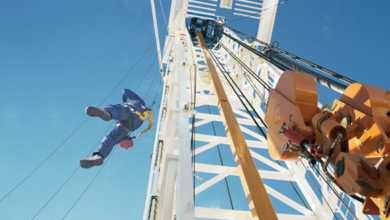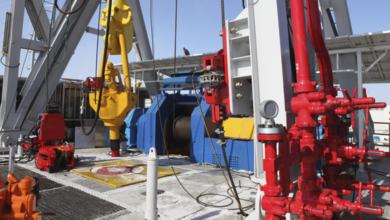Drilling and Completion: Tech Digest
World’s 1st rotary steerable liner-while-drilling system tested on Brage platform
World’s 1st rotary steerable liner-while-drilling system tested on Brage platform Statoil has successfully tested the world’s first rotary steerable liner-while-drilling system from its Brage platform in the Norwegian sector of the North Sea. The new technology was jointly developed by Statoil and Baker Hughes. The concept of a rotary steerable system that gives operators the ability to accurately drill and log 3D well profiles with a liner attached directly to the drillstring

is new. The system is designed to withstand high circulation rates and high torque loads while providing liner connect and disconnect capabilities. Following a second deployment in January at Statoil’s Statfjord Field, the new technology will be commercialized.
In conventional drilling operations, the drillstring must be pulled before running the casing or liner. Liner drilling systems eliminate the need to pull the drillstring to run casing, saving time and drilling costs by minimizing the risk of borehole collapse and reducing NPT. The addition of rotary steerable capabilities helps overcome the challenges of drilling in zones with lower pressure and unstable shale/coal layers and in formations with varying flow and pressure regimes. This breakthrough technology was tested extensively onshore before being run on Brage.
Shell deploys open-water wireline at record depth
Shell and Oceaneering International set an industry record in subsea well intervention by replacing a failed subsurface-controlled subsurface safety valve in the Gulf of Mexico using the open-water wireline technique at a water depth of 2,673 ft (815 m). This is a record for producing wells. Open-water wireline had previously been deployed only in shallower waters. “This achievement is much more than a short-term record-breaking success. It is a game changer. Over the last 10 years, this technology reduced both the costs and frequency of interventions in shallow water, and I am confident we will see the same in deepwater,” said Peter Sharpe, Shell executive vice president – wells.
Oceaneering’s subsea intervention lubricator system is designed to perform wireline-based subsea well interventions without a drilling rig or large multiservice vessel and workover riser.
Longest solid expandable tubular liner cementation sets world record
BJ Services recently set a world record for cementing the longest solid expandable tubular liner for an operator in the Gulf of Mexico. Separately, the company also completed the 25th application of its ComPlete multizone single-trip (MST) system with a successful five-zone completion on the Sisi-Nubi project in the Mahakam Delta offshore Indonesia.
In the GOM world record, the 6,935-ft (pre-expansion length) 7 5/8-in. liner was set and cemented with a shoe depth below 20,000 ft (6,000 m). BJ used a custom-made XtremeSet cement slurry system to isolate the deep wellbore section, which had bottomhole static temperatures of 368°F (187°C).
To seal the annulus, BJ formulated the slurry to remain fluid for more than 15 hours downhole, permitting the expansion of the liner. Cementing specialists conducted extensive laboratory testing and simulation modeling to determine the proper circulating temperature for the application and precise additive package.
The custom slurry formulation weighted 18.7 ppg (2.24 g/cc) against a mud weight of 17.9 ppg (2.14 g/cc). The system performed as designed, yielding good density control, minimal fluid loss and zero free water. After drill-out and a leak-off test to 19 ppg (2.28 g/cc) equivalent mud weight, the operator commenced drilling with no need for remedial operations.
In the Indonesia project, the completion for Total E&P Indonesia involved five high-rate water-pack operations using a 9 5/8-in. system. The MST system required 3.8 days of operating time, saving an estimated 12 days of rig time. The well represents the 15th such completion for the operator since 2007.
BJ received a patent in June 2009 for the MST system’s ability to reliably isolate and stimulate individual zones of a multizone well in one trip. After securing positive, independent isolation of each zone with dual-element isolation packers, the system permits a variety of stimulation and sand placement techniques with little restriction to zone lengths and distance between intervals.
Assemblies for all zones are made on surface, and the assembly is run into the wellbore in one trip. After the zones are isolated and treated, an upper production string is run, enabling selective or commingled production through the opening and closing of production sleeves. The operator could even complete some zones and return later to complete the remaining intervals of interest.
Baker Hughes runs 24-stage completion in Williston Basin

Baker Hughes in late 2009 successfully ran a 24-stage completion in the Williston Basin for Whiting Petroleum Corp – among the largest number of stages ever run using a ball/sleeve method for isolation. The Baker Oil Tools FracPoint EX multistage fracturing system used on the Ogden 11-3H well allowed the single-trip isolation of 24 intervals with an 8,000-psi pressure rating, while achieving high frac rates through all the ball seats.
The Bakken Shale/Three Forks play in North Dakota has seen an increase in activity due to fracturing improvements using multistage open-hole packer and sleeve systems. Advances in completion product development are enabling Baker Hughes to develop increasingly more complex fracturing systems that can be deployed in one trip, reducing the steps required to successfully complete a well.
This job was the first 24-stage FracPoint EX system Baker Hughes has deployed globally.
Riserless mud recovery system used for 1st time in Gulf of Mexico
Statoil has become the first operator in the US Gulf of Mexico to adopt AGR’s riserless mud recovery (RMR) system, which reduces discharges to sea, on the Discoverer Americas drillship on the Krakatoa prospect.
The Krakatoa well, in 2,060 ft (620 m) water depth, is the first application of RMR in the GOM. “The RMR system allows us to circulate the mud, reducing the total mud consumption and discharges to sea to a quarter of the amount compared with conventional methods,” said Tore Grønås, Statoil superintendent for the Discoverer Americas.
Mud costs and its transportation costs were also significantly reduced.
“In addition, this technology allows us to push the drilling depth deeper for the shallow casing string, which again reduces the overall drilling time per well,” he said.
“Minimizing the number of casing strings down to the reservoir is crucial for the success, especially within deepwater drilling where you may run out of options. With RMR technology, we have the opportunity to reduce the required number of casing strings and thereby reduce the total well cost by several millions of US dollars,” Mr Grønås added.
Statoil currently has two drilling units in operation in the Gulf of Mexico. RMR technology has been successfully used by Statoil on the Norwegian Continental Shelf in 19 operations.
The RMR system has been qualified and field-proven to water depths of 5,000 ft (1,525 m). It is being tested and qualified to be used in even deeper waters. RMR technology is used prior to installing the drilling riser, which means at the start of the well.
Terry Scanlon, AGR senior vice president – Americas, commented, “This is exactly the kind of well opportunity we were looking for on our first well in the GOM – top-hole instability with shallow water flow and shallow gas flow concerns – to establish our game-changing technology and services capability on these difficult GOM wells. “
Statoil used the RMR system with a four-stage pump on their GOM Krakatoa well top-hole section and, as a result, managed to maintain top-hole stability, circulate through unconsolidated water flow and gas flow formations and managed to push the 22-in. casing setting depth significantly deeper than had been achieved previously on offset wells. The system was deployed over the side, thus not interfering with direct line rotary table/moonpool activities.
Cameron MARS installs world’s 1st deepwater scale squeeze
Chevron has completed its first deepwater scale squeeze treatment using Cameron’s MARS (multiple application re-injection system) on well LDN4 in the Lobito Tomboco field in Angola.
The MARS system can be described as “a USB port for wellheads” and has previously been used for BP and Total for deepwater subsea pumping and metering projects. The MARS system, previously used for chemical injection operations by Shell in North Sea, has been extended for deepwater scale squeeze operations up to 600 m, with plans for extending the technology to 1,500 m. Chevron will use this system on 13 specially modified wells within the same asset to maximize production through the life of the field. The total scope of supply from MARS-PS included the deployment and chemical handling interfaces in addition to the MARS hardware.



